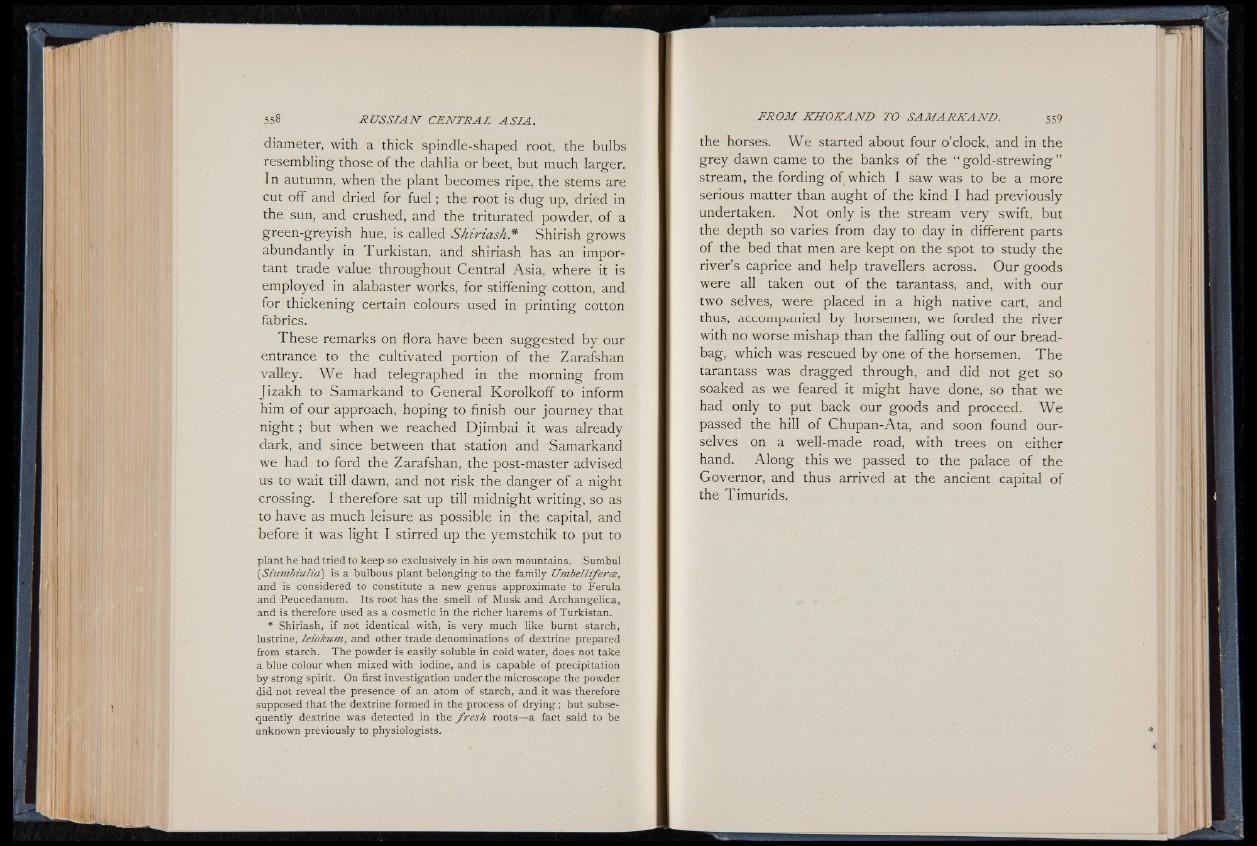
diameter, with a thick spindle-shaped root, the bulbs
resembling those of the dahlia or beet, but much larger.
In autumn, when the plant becomes ripe, the stems are
cut off and dried for fu e l; the root is dug up, dried in
the sun, and crushed, and the triturated powder, of a
green-greyish hue, is called S h iria sh* Shirish grows
abundantly in Turkistan, and shiriash has an important
trade value throughout Central Asia, where it is
employed in alabaster works, for stiffening cotton, and
for thickening certain colours used in printing cotton
fabrics.
These remarks on flora have been suggested by our
entrance to the cultivated portion of the Zarafshan
valley. We had telegraphed in the morning from
Jizakh to Samarkand to General Korolkoff to inform
him of our approach, hoping to finish our journey that
n ig h t; but when we reached Djimbai it was already
dark, and since between that station and Samarkand
we had to ford the Zarafshan, the post-master advised
us to wait till dawn, and not risk the danger of a night
crossing. I therefore sat up till midnight writing, so as
to have as much leisure as possible in the capital, and
before it was light I stirred up the yemstchik to put to
plant he had tried to keep so exclusively in his own mountains. Sumbul
(Siumbiulia) is a bulbous plant belonging to the family Umbelliferce,
and is considered to constitute a new genus approximate to Ferula
and Peucedanum. Its root has the smell of Musk and Archangelica,
and is therefore used as a cosmetic in the richer harems of Turkistan.
* Shiriash, if not identical with, is very much like burnt starch,
lustrine, leiokum, and other trade denominations of dextrine prepared
from starch. The powder is easily soluble in cold water, does not take
a blue colour when mixed with iodine, and is capable of precipitation
by strong spirit. On first investigation under the microscope the powder
did not reveal the presence of an atom of starch, and it was therefore
supposed that the dextrine formed in the process of d ryin g ; but subsequently
dextrine was detected in the fr e s h roots— a fact said to be
unknown previously to physiologists.
the horses. We started about four o’clock, and in the
grey dawn came to the banks of the “ gold-strewing ”
stream, the fording of which I saw was to be a more
serious matter than aught of the kind I had previously
undertaken. Not only is the stream very swift, but
the depth so varies from day to day in different parts
of the bed that men are kept on the spot to study the
river’s caprice and help travellers across. Our goods
were all taken out of the tarantass, and, with our
two selves, were placed in a high native cart, and
thus, accompanied by horsemen, we forded the river
with no worse mishap than the falling out of our bread-
bag, which was rescued by one of the horsemen. The
tarantass was dragged through, and did not get so
soaked as we feared it might have done, so that we
had only to put back our goods and proceed. We
passed the hill of Chupan-Ata, and soon found ourselves
on a well-made road, with trees on either
hand. Along this we passed to the palace of the
Governor, and thus arrived at the ancient capital of
the Timurids.